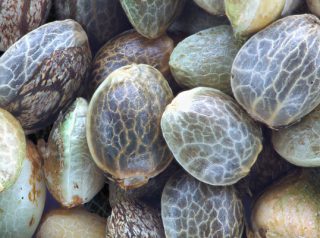So you’re out of weed and, as you frantically search all four corners of your now disarranged house, you discover a long-forgotten bud baggie. The flowers still look okay, but how long is it good for? Will an old, dried out marijuana taste awful or make you sick?
Wonderful questions! A lot of Mary Jane fans have the same concerns. The great news is weed does not have an expiration date and can last a long time if stored properly. On the unfortunate flip side, cannabis flowers’ quality drops after a while, and some unwanted properties may infiltrate the bud and its resin.
Page Content
Weed Shelf Life: What You Need to Know
The average shelf life of a properly harvested, dried, and cured cannabis buds is 6 months to 1 year. Notice the keyword here is “properly,” as any form of contamination would make the buds unsuitable for consumption.
Unlike perishable foods, such as dairy, fish, and meat, marijuana doesn’t spoil and cause food poisoning. It won’t go bad if processed and stored correctly. In fact, you can even stretch its shelf life for up to two years (but let’s save that for later).

Dried pot is more like preserved herbs used in cooking — it won’t have the same impact and effects as fresher buds. The aroma, flavors, and potency will diminish. As long as no mold or any foreign matter that shouldn’t be there has developed, though, you won’t get sick from consuming it. Here’s what users can expect as per University of Mississippi’s research:
- Up to 16.6% of THC loss after one year
- Up to 26.8% of THC loss after two years
- Up to 34.5% of THC loss after three years
- Up to 41.4% of THC loss after four years
To put it simply, the older the weed gets, the weaker its overall impact becomes.
Signs Your Weed Has Gone Bad
Much like when checking food, your five senses — touch, sight, hearing, smell, and taste — will tell if your weed has gone wrong. Here’s when you really have to trust your senses and toss out your old marijuana from wherever it’s been hiding:

Looks bone-dry and/or moldy. Overaged cannabis tends to be dry and crisp as if it would crumble when touched. Old buds may also be cloaked in white molds, which newer users may mistake as trichomes. If you see a gray or white powdery appearance instead of glittery little hairs and undesirable, musty odor, then it’s most likely mildew.
It’s the wrong texture. If the buds from the old stash don’t look right, but you’re still unsure, try checking with your fingers. A good weed is soft yet firm to the touch. It may be hosting a mold growth if the flower feels too wet or moist. On the other hand, if you take a tiny part of the pot and it crumbles to dust, then it got too dry.
Makes a crackling sound. Your weed is still okay if it’s firm and you hear a snap when breaking it apart. Do the same to old flowers, and they will crackle and fall apart like crunchy, dry autumn leaves.
Weak Smell. Fresh cannabis is brimful of terpenes, which provide the buds their distinct fragrance. The most common yet popular scent notes are citrusy, earthy, grassy, mossy, piney, and woodsy. No matter how robust the aroma is at the beginning, the terpenes will degrade over time. Flowers will gradually lose their olfaction appeal, indicating that they are way past their prime.
On the other hand, if moisture has penetrated the buds and mold has developed, users will notice a damp, musty smell. If this odor is observed, along with other signs of moldy weed, do not take it on a smoke test and just send the stash to the trash.
Tastes bland or moldy. Old cannabis that has lost most of its terpenes and flavonoids would taste dull and be impossible to enjoy gustatorily.
In a worst-case scenario, should signs of molds be ignored, users may even inhale the bitter and musty smoke of bad weed, so make sure to inspect before taking a hit.
Ways to Keep Your Weed Fresh Longer
Heat, light, and moisture are the primary causes of cannabis degradation. So, if you want your stash to stay fresh for a year or longer, rid your hiding spot of the three weed destroyers. Here’s how you do it:

Eliminate excess moisture. A damp environment deteriorates cannabis quality and may cause pathogen contamination. Avoid this by keeping the RH level in the storage area no more than 65%.
Keep it cool. Store your weed at temperatures between 60 to 70°F (16 to 21°C) and avoid reaching 77 to 86°F (25 to 30°C) — the preferred condition of molds.
Hide in the dark. Keep your stash in the dark as light diminishes THC and other cannabinoids. Ultraviolet light causes the worst damage, and your weed only needs little exposure to incur serious degradation. Sunlight, CFL, and LED lights emit small to moderate amounts of UV. This makes avoiding its rays difficult and hiding your weed in a dark place or spot vital.
Modulate environmental conditions. Store your pot in a climate-controlled container. Several receptacles are designed to regulate temperature, humidity, and light, but you may also use an airtight mason jar and keep it in a dark, cool spot like a closet or drawer.
Freezing Pot For Longer Shelf Life — Does It Work?
A freezer is an excellent storage for highly perishable products. When closed, it is a cool, dark, and dry space, so, naturally, many pot enthusiasts assume it can be great for storing weed and preserving its quality. In truth, however, freezing destroys the marijuana plant’s natural chemical processes and quality. Let me explain why.
First, a freshly harvested cannabis needs to age for a number of days to get rid of excess moisture and cure the flowers. During this time and even after, as it sits in a container, the buds decarboxylate, which turns the THC-A (acid) into the psychoactive THC. The low temperatures in a freezer will slow down or completely halt the decarboxylation process, resulting in less potent weed over time.
Second, freezing cannabis adds to the fragility of its trichome crystals. It will cause them to easily fall off at the slightest movement. What’s the big deal with these glittery, hair-like structures? Well, trichs contain terpenes, flavonoids, and cannabinoids — almost everything that makes weed potent, enjoyable, and beneficial — so you have to avoid anything that will cause them to deteriorate or come off. The only time freezing marijuana buds is a good idea is when making concentrates like ice-bubble hash as extraction is a lot easier with frozen buds.
Can You Get Sick From Smoking Old Marijuana?
If old marijuana buds aren’t “good” anymore, doesn’t it mean they have expired? Well, cannabis plants do not spoil or rot the way dairy, seafood, and meat do. Users won’t get sick from smoking old, dry weed, but expect less potency, bland flavors, and a lighter buzz.
On the other hand, if the cannabis buds show signs of mold growth, do not simply get rid of the affected area and smoke the rest. Instead, discard them promptly, as ingesting toxigenic mold spores will send them directly to your respiratory system. It can lead to serious allergic reactions or cause severe lung infections, even in healthy people.
Additionally, smoking old, mold-impacted weed may prompt coughing, headaches, runny nose, shortness of breath, stuffiness, and wheezing. Users with allergies, asthma, or weak immune systems are likely to experience acute symptoms.
Old Weed Can Still Be Good
Unlike wine, cannabis is at its most optimal state when fresh, and it doesn’t get better with time. Still, if a thorough inspection deems an old stash of weed safe for consumption, then feel free to take a hit. The experience may not be as enjoyable or as hard-hitting as it would have been months or perhaps a year ago, but it’s still way better than nothing. If the supply was kept away from heat, light, and moisture, then it enjoys a longer shelf-life and the quality may still be pretty good. Just be wary of any signs of mold growth, such as white powdery specks on the bud and musty smell. And remember, if in doubt, toss it out.





